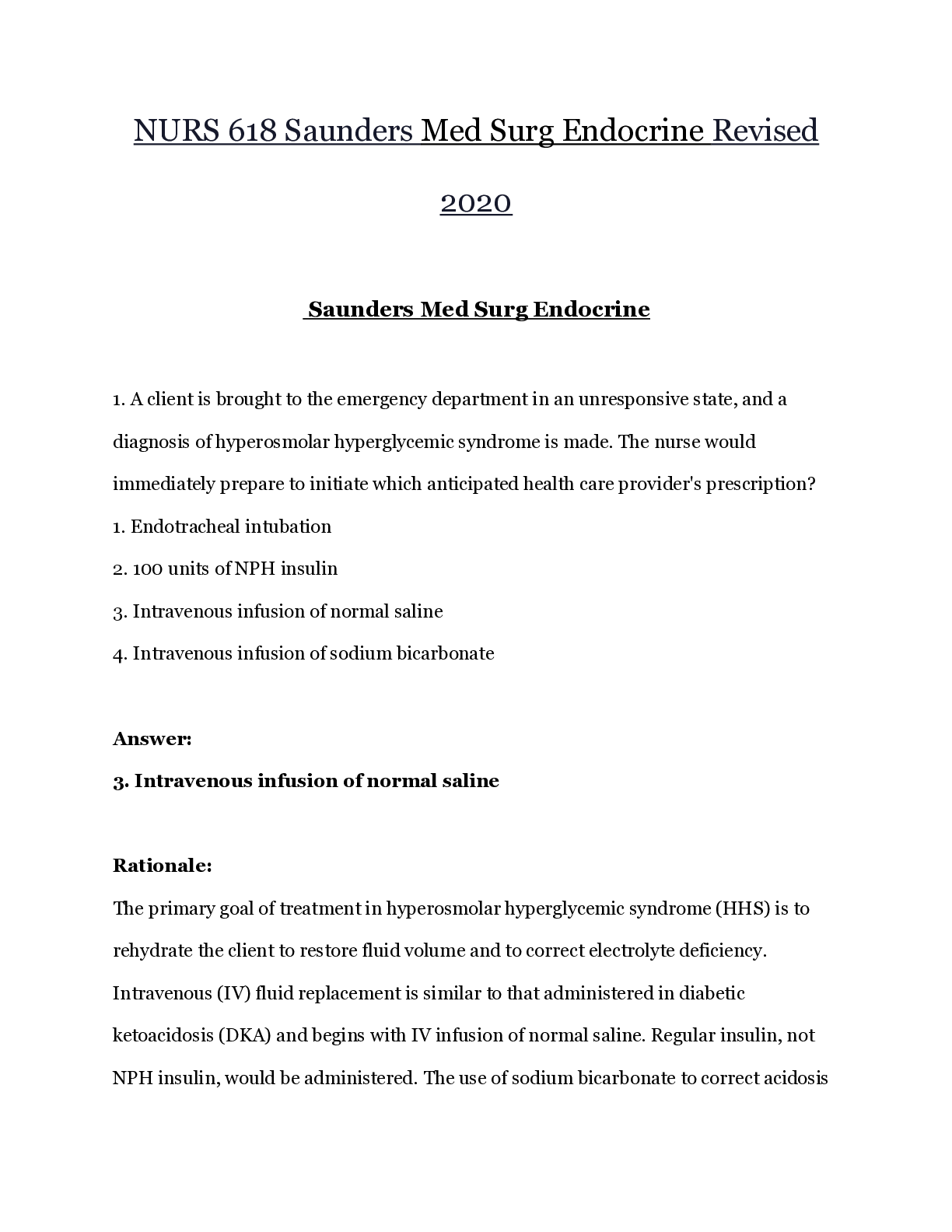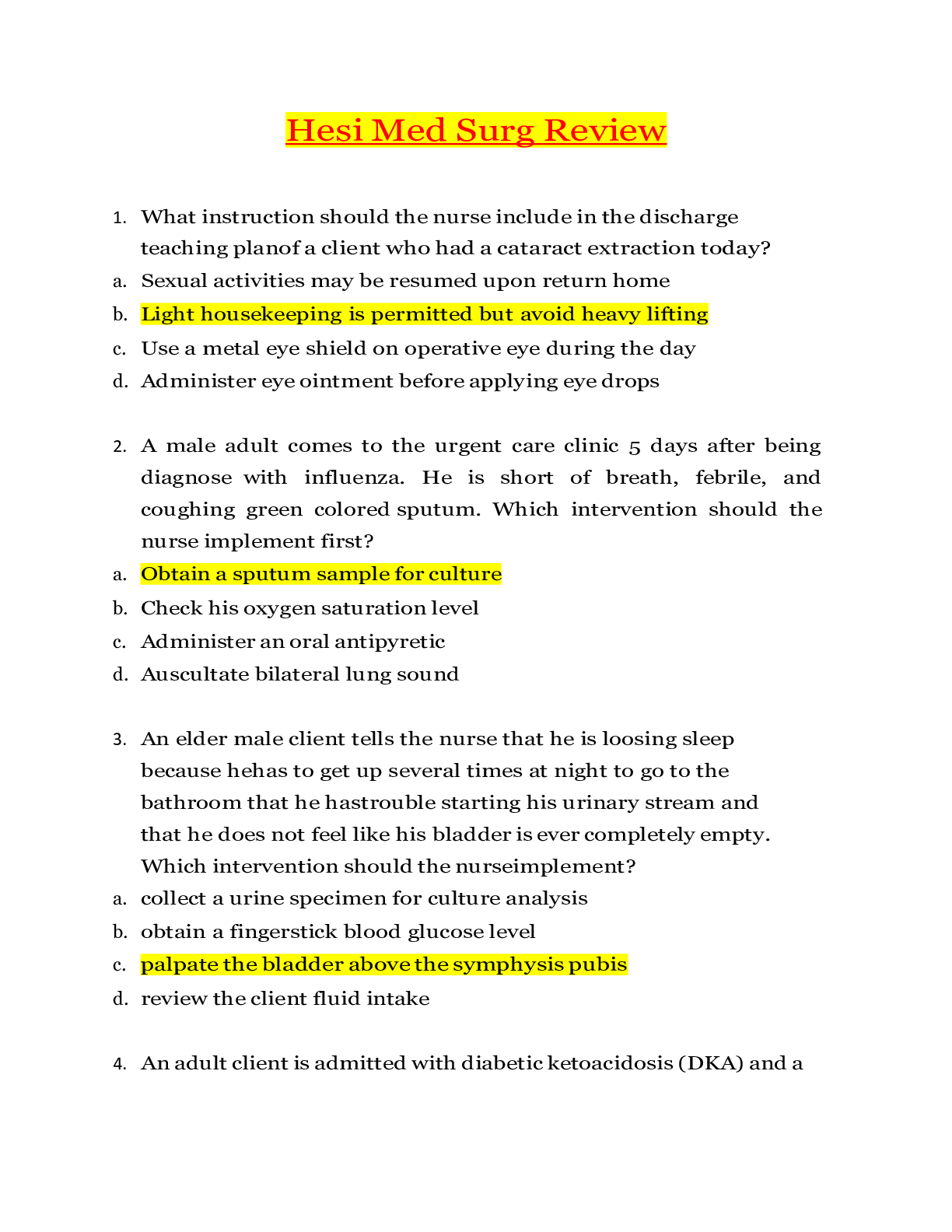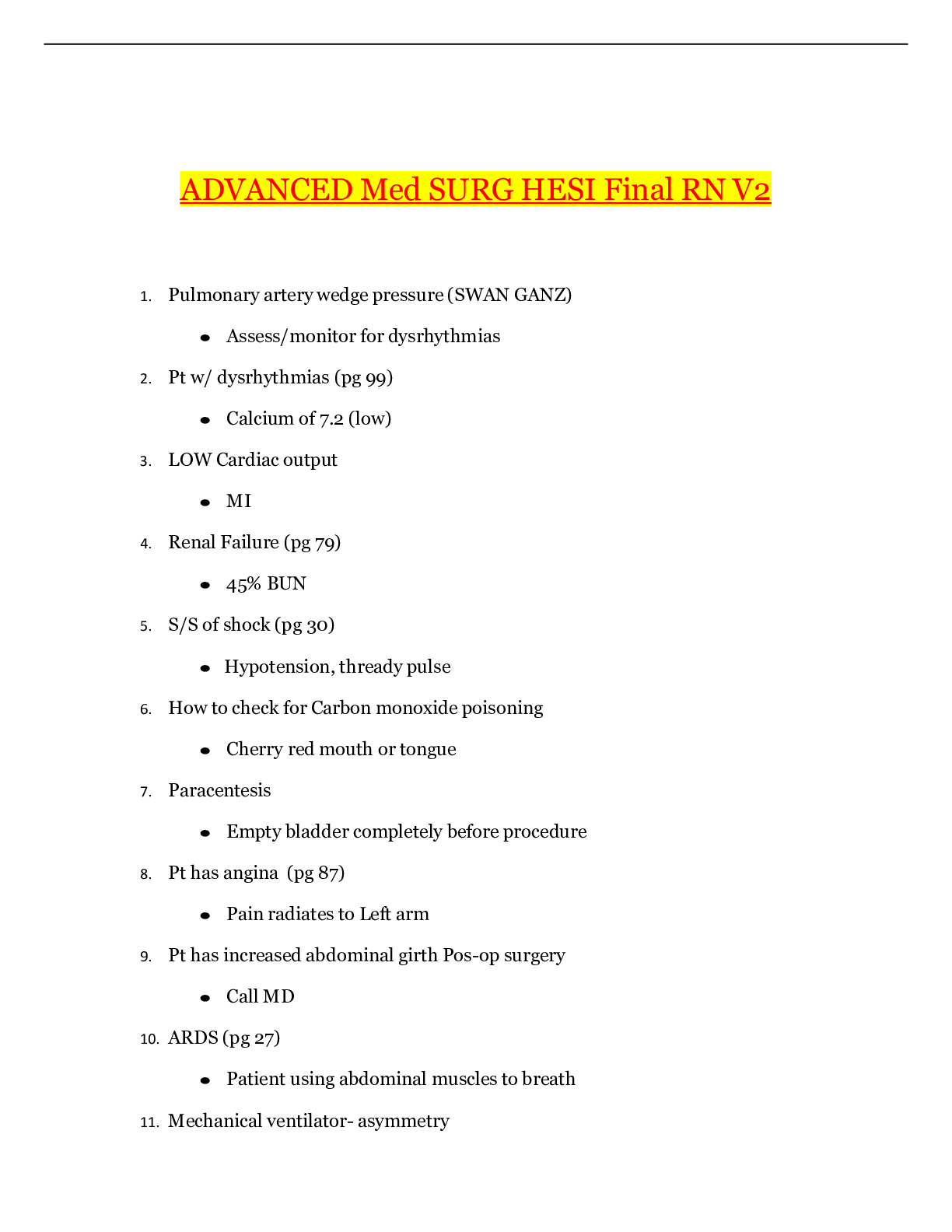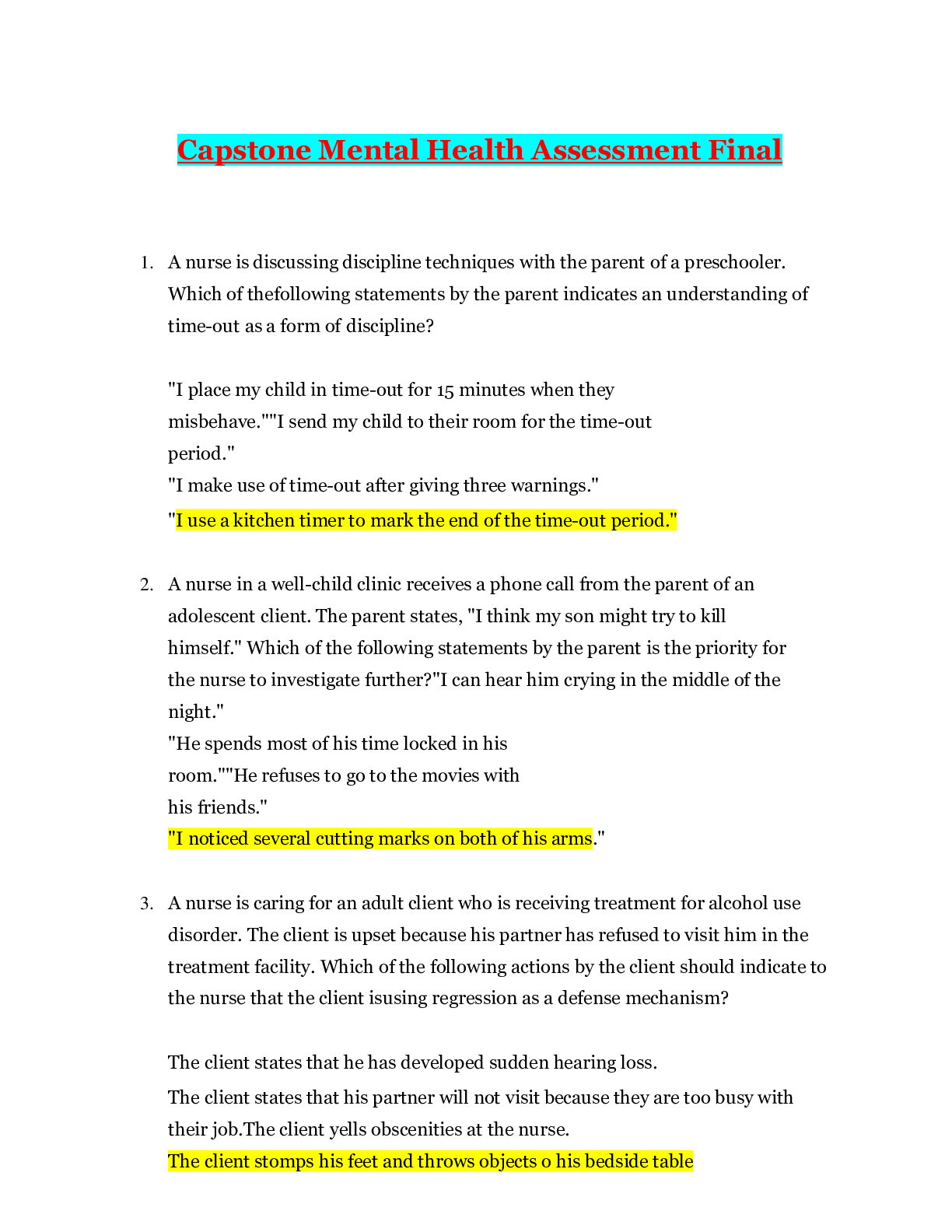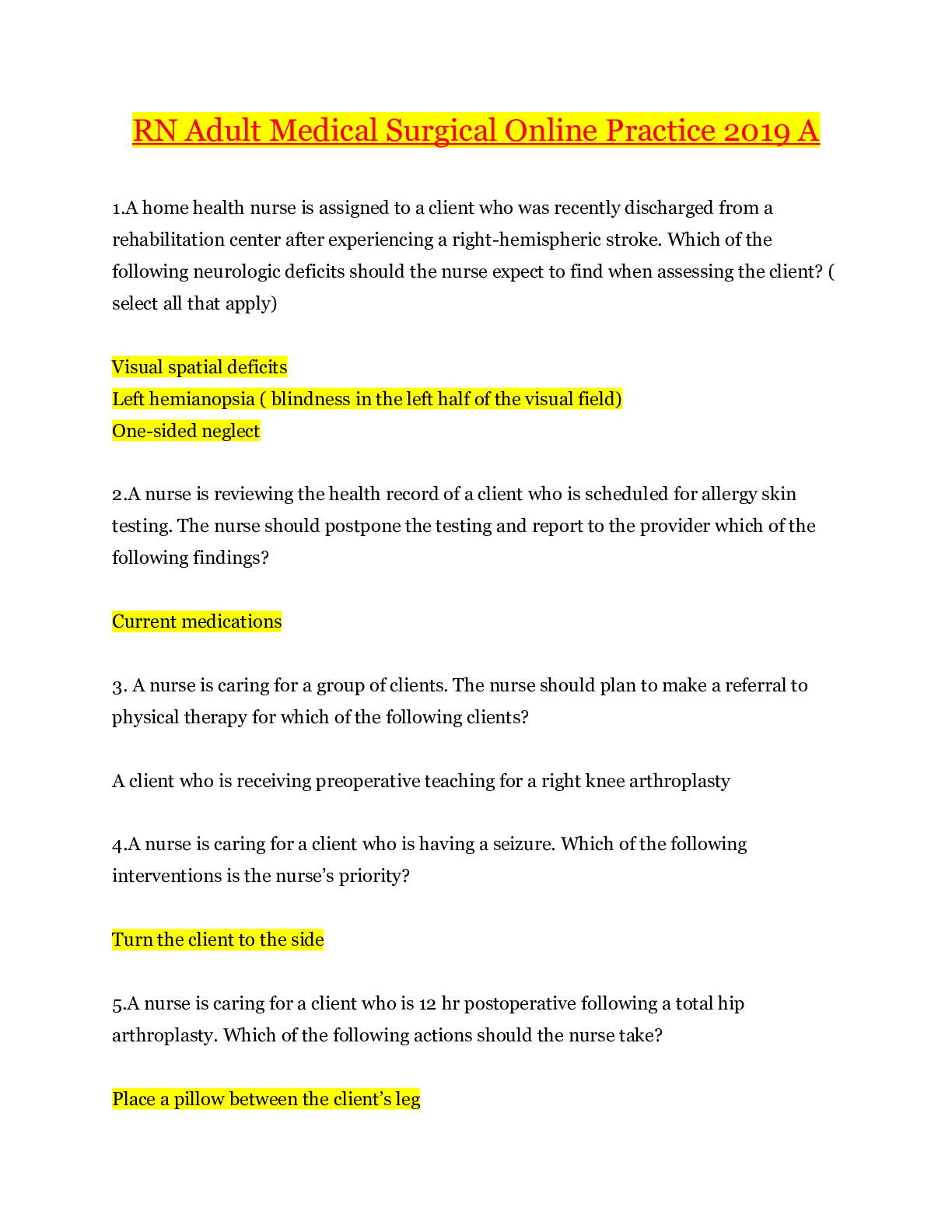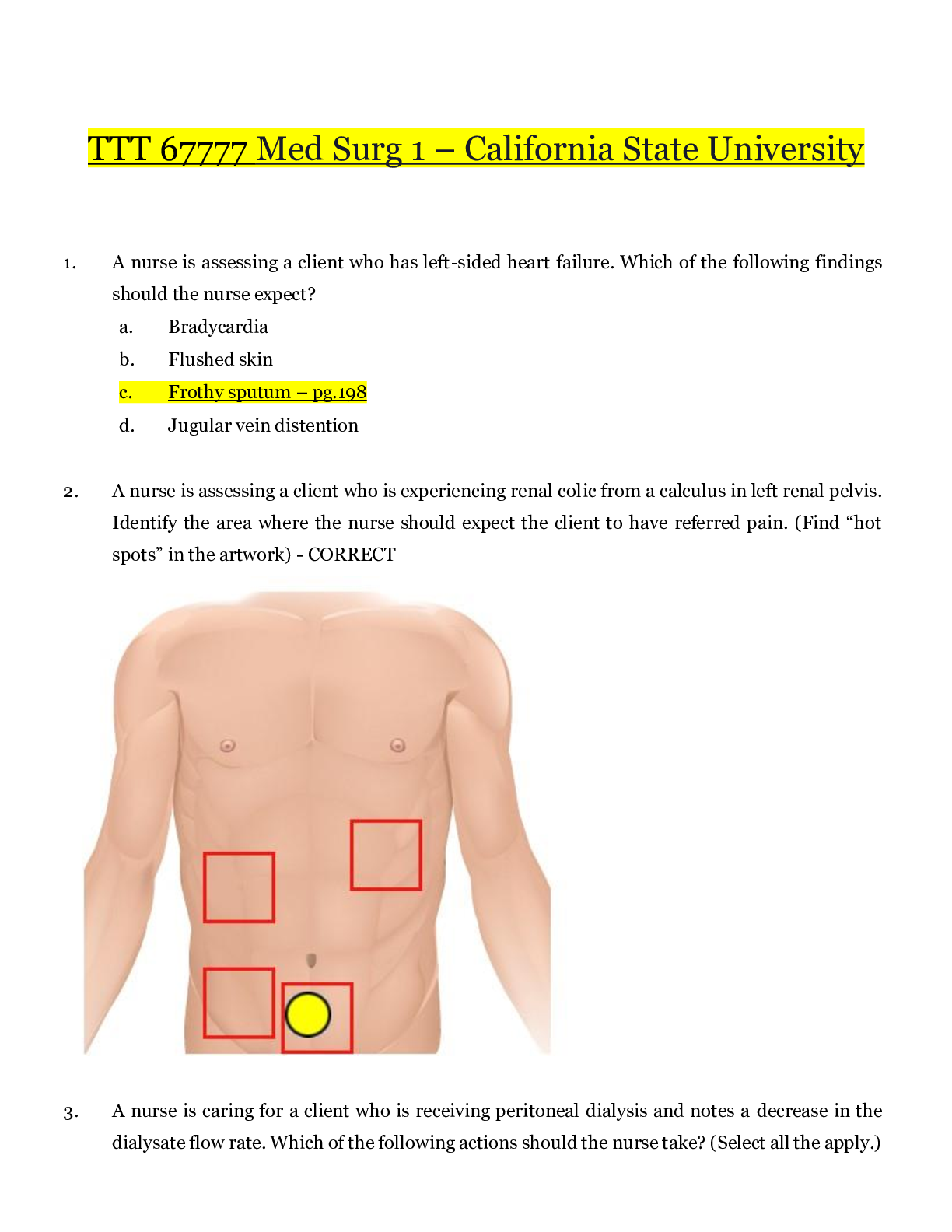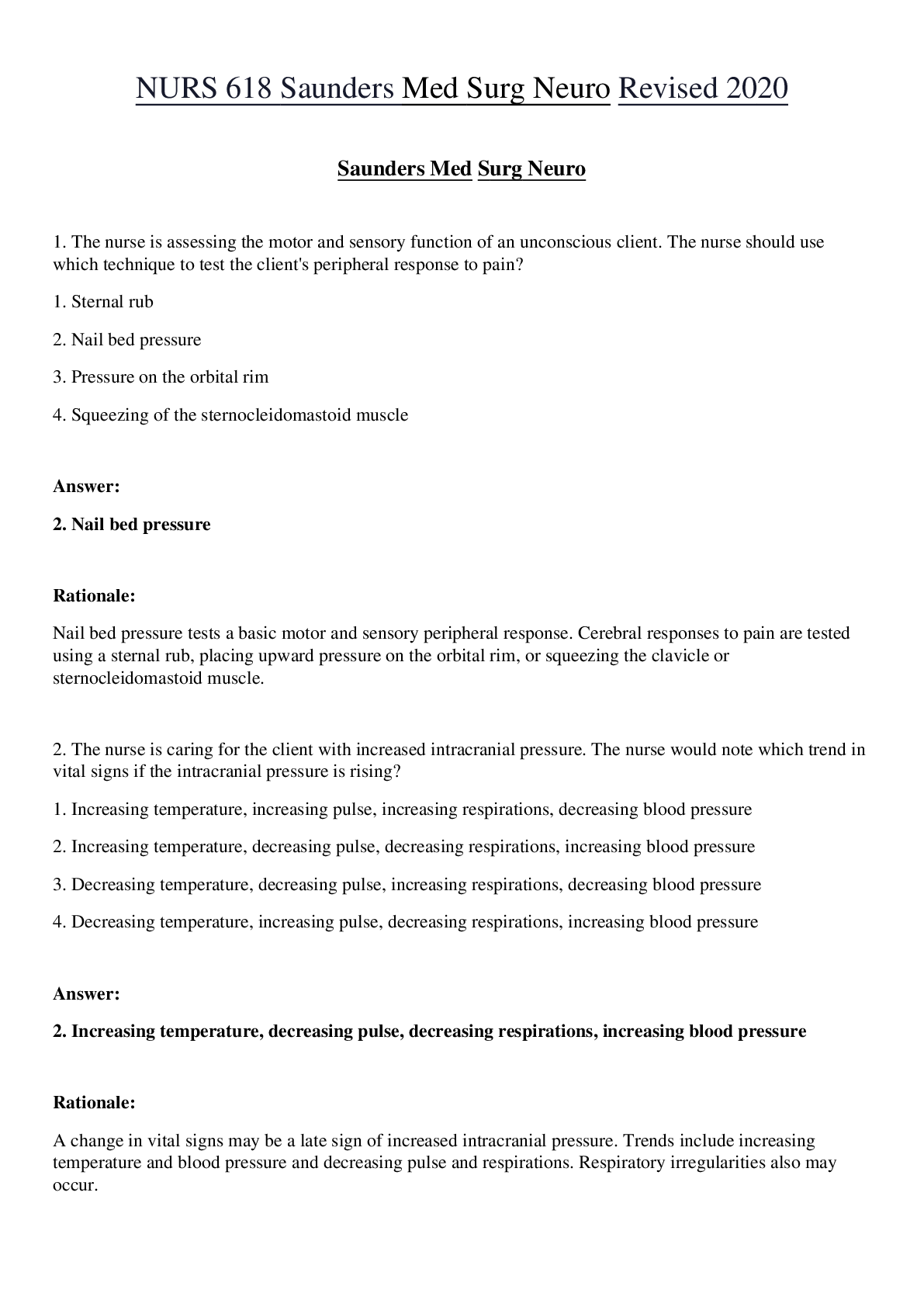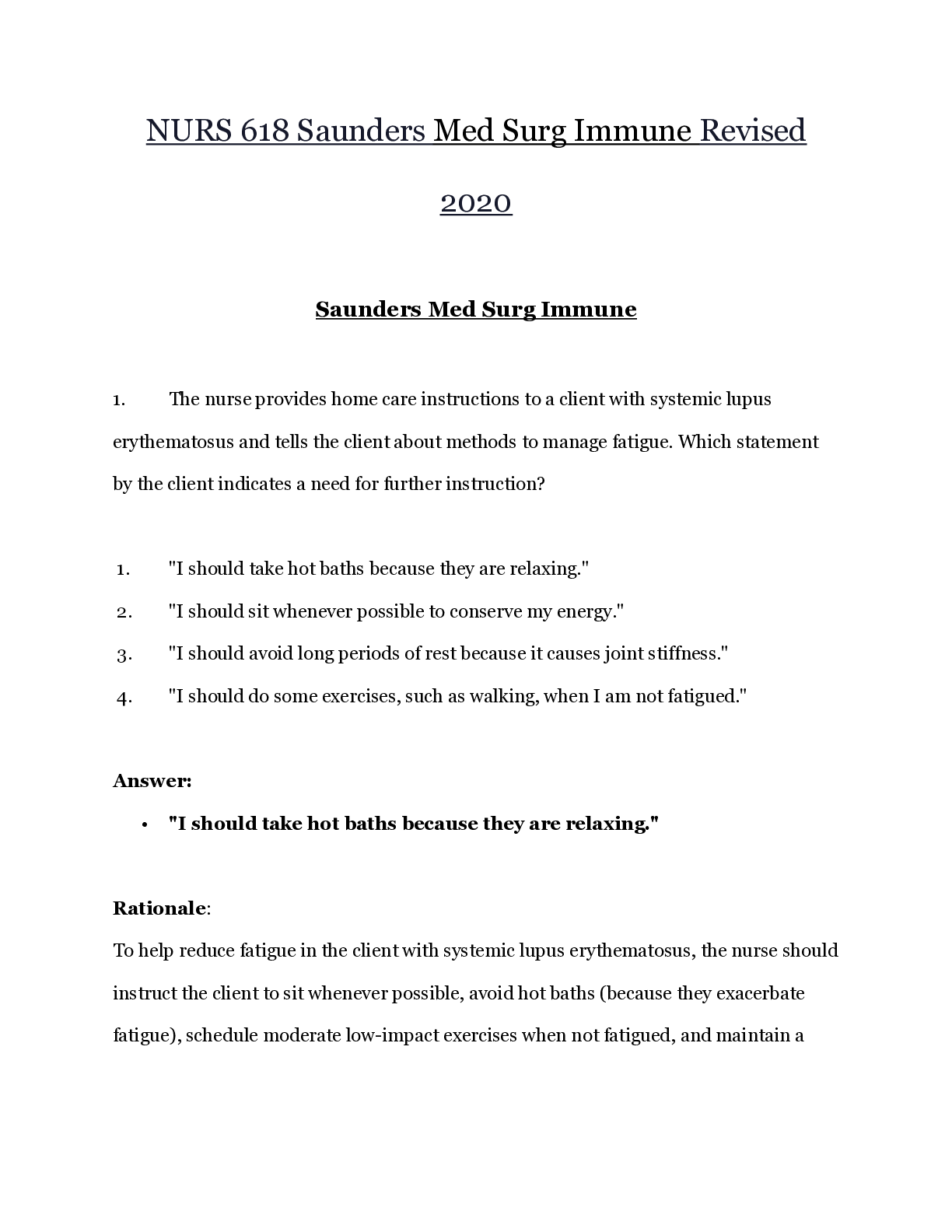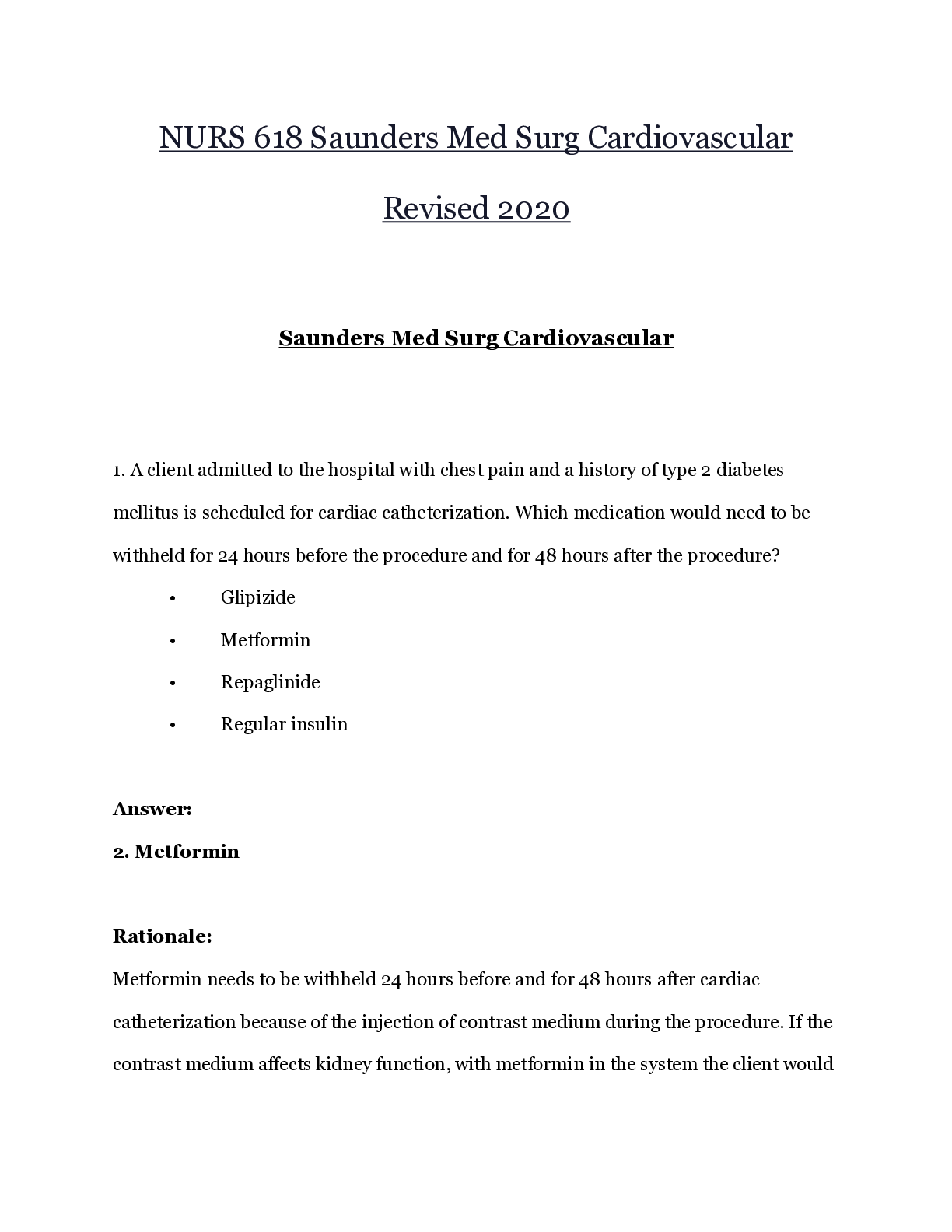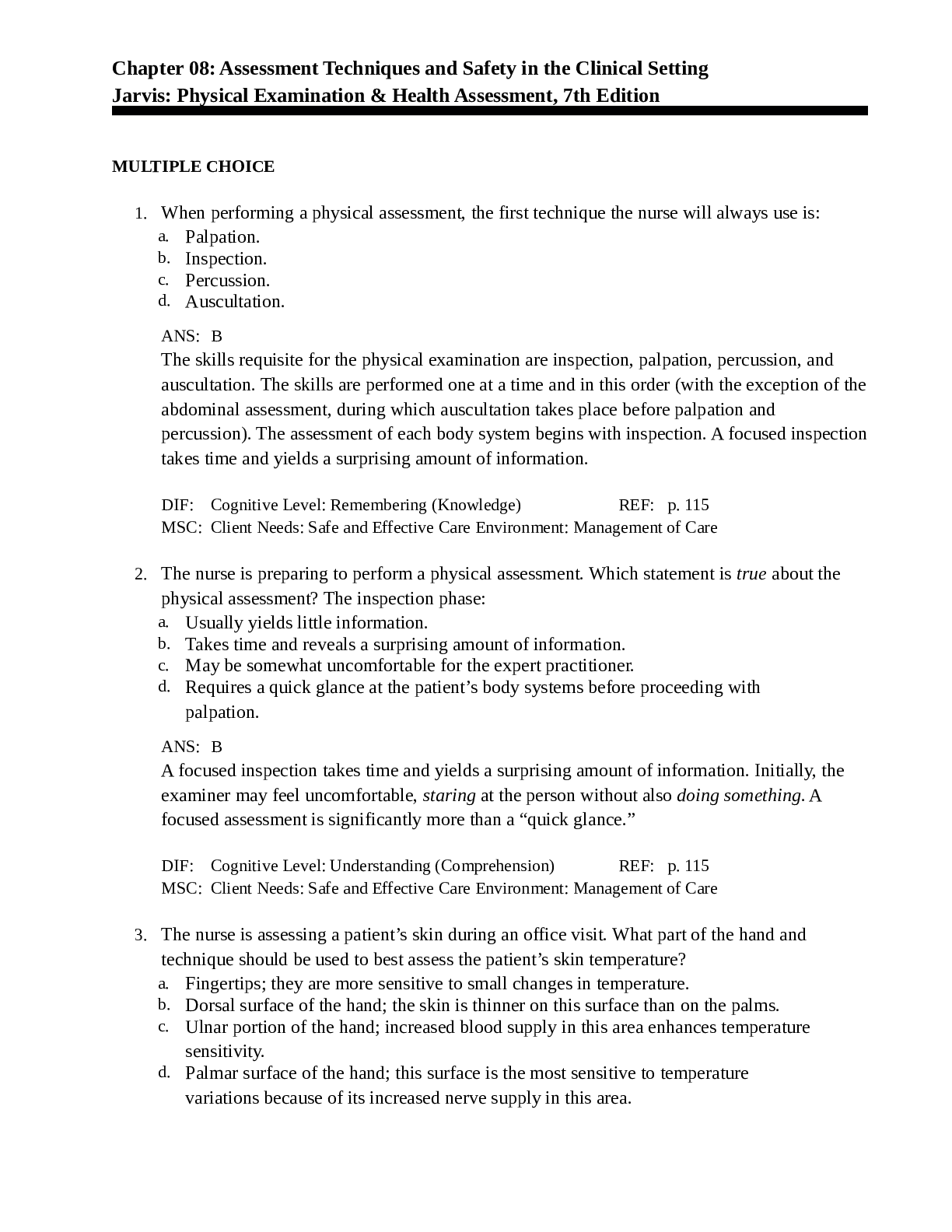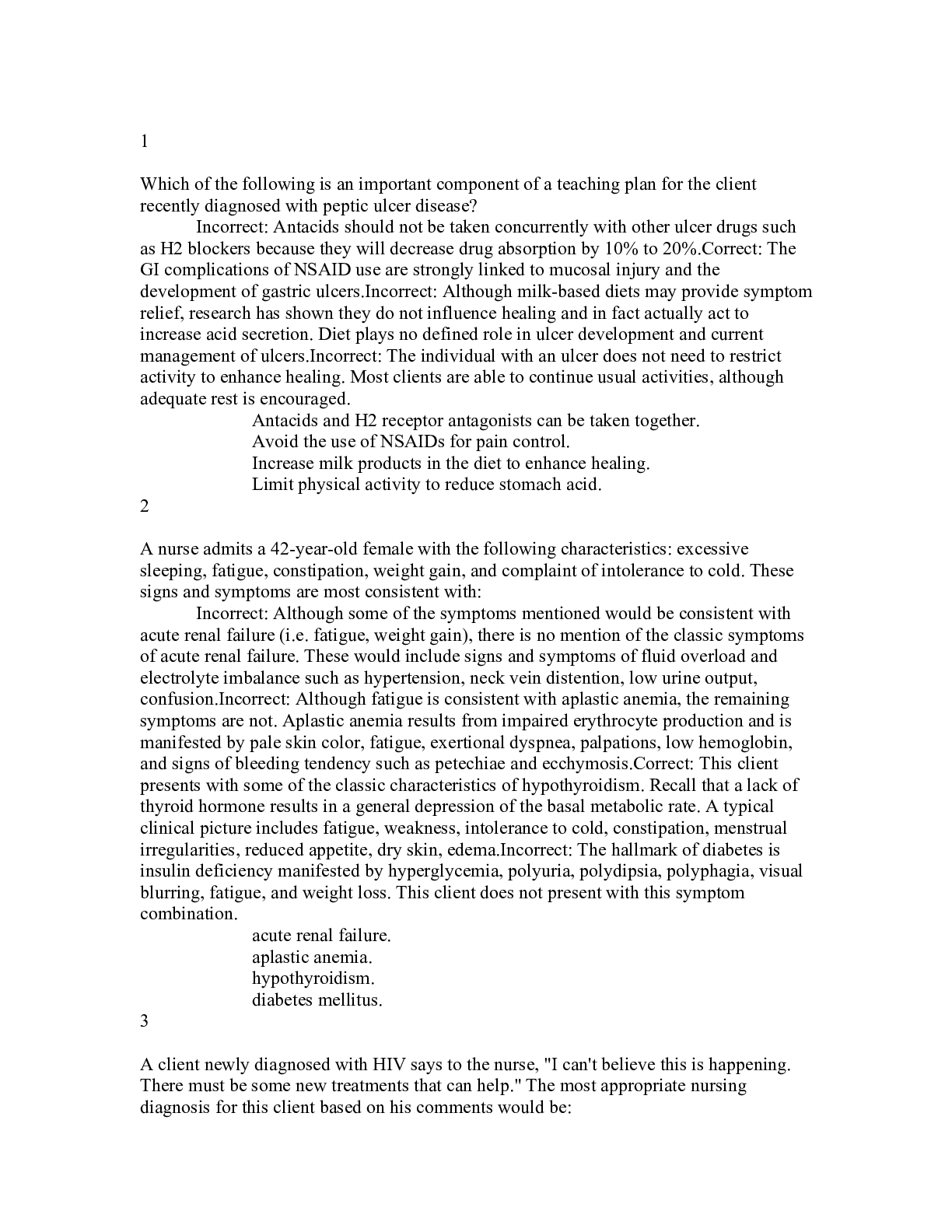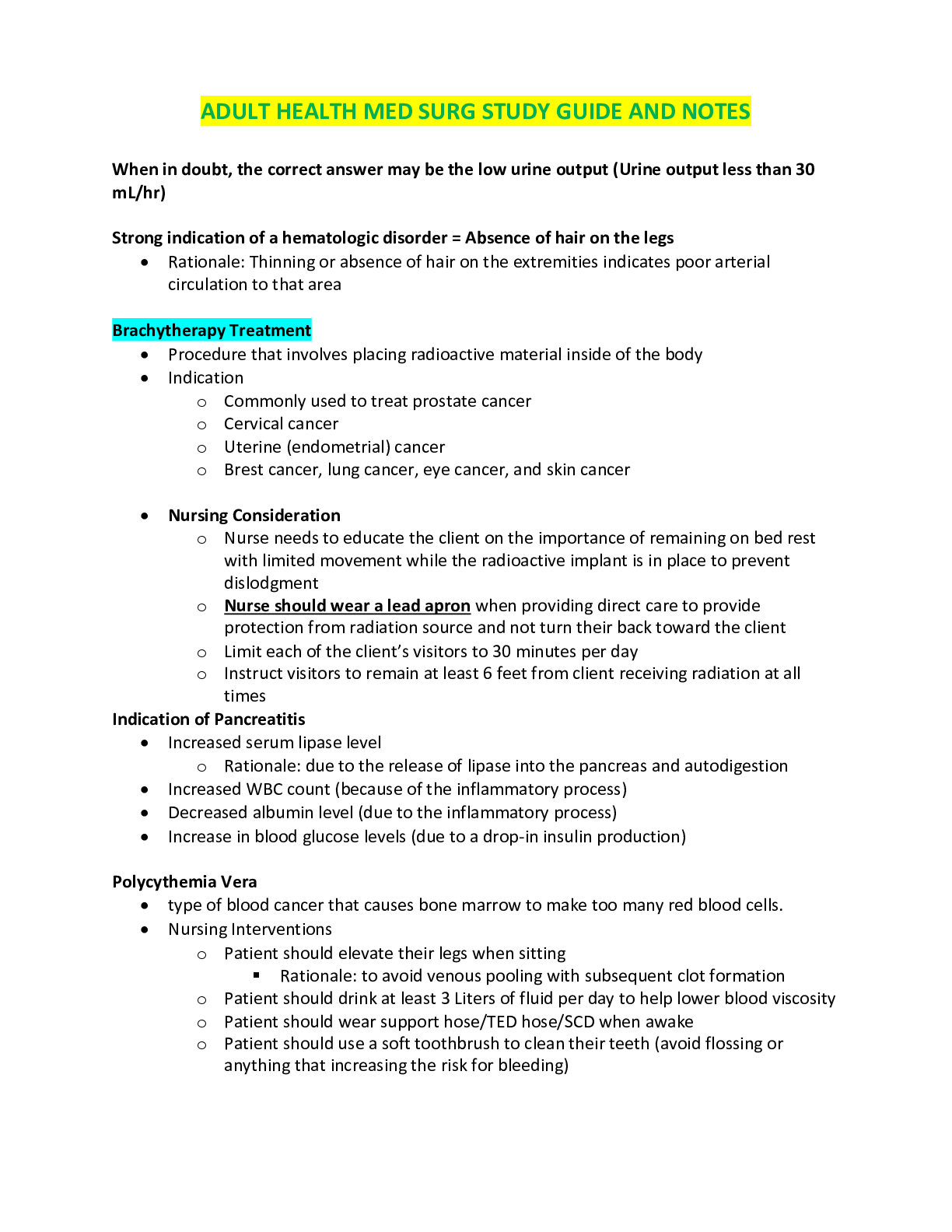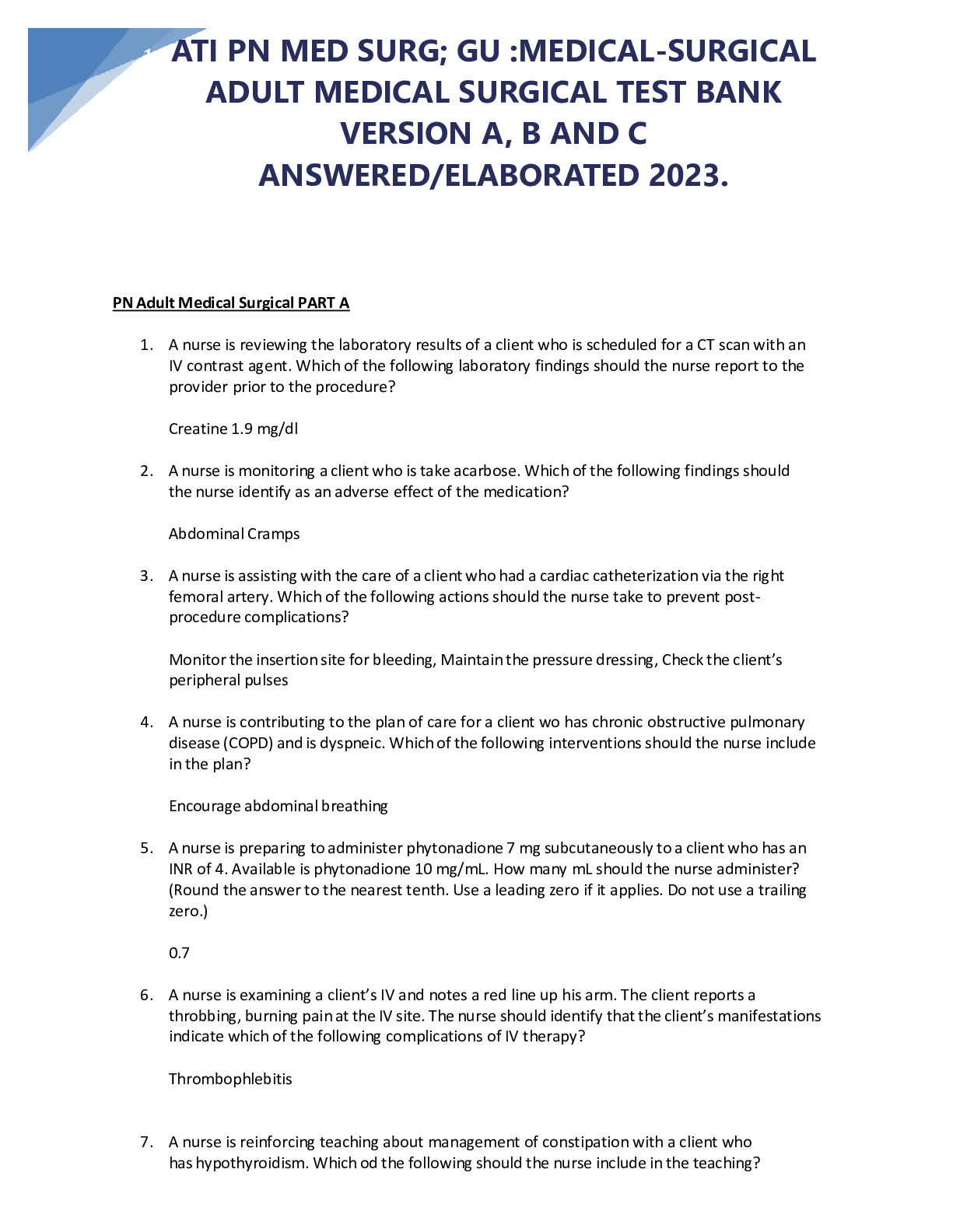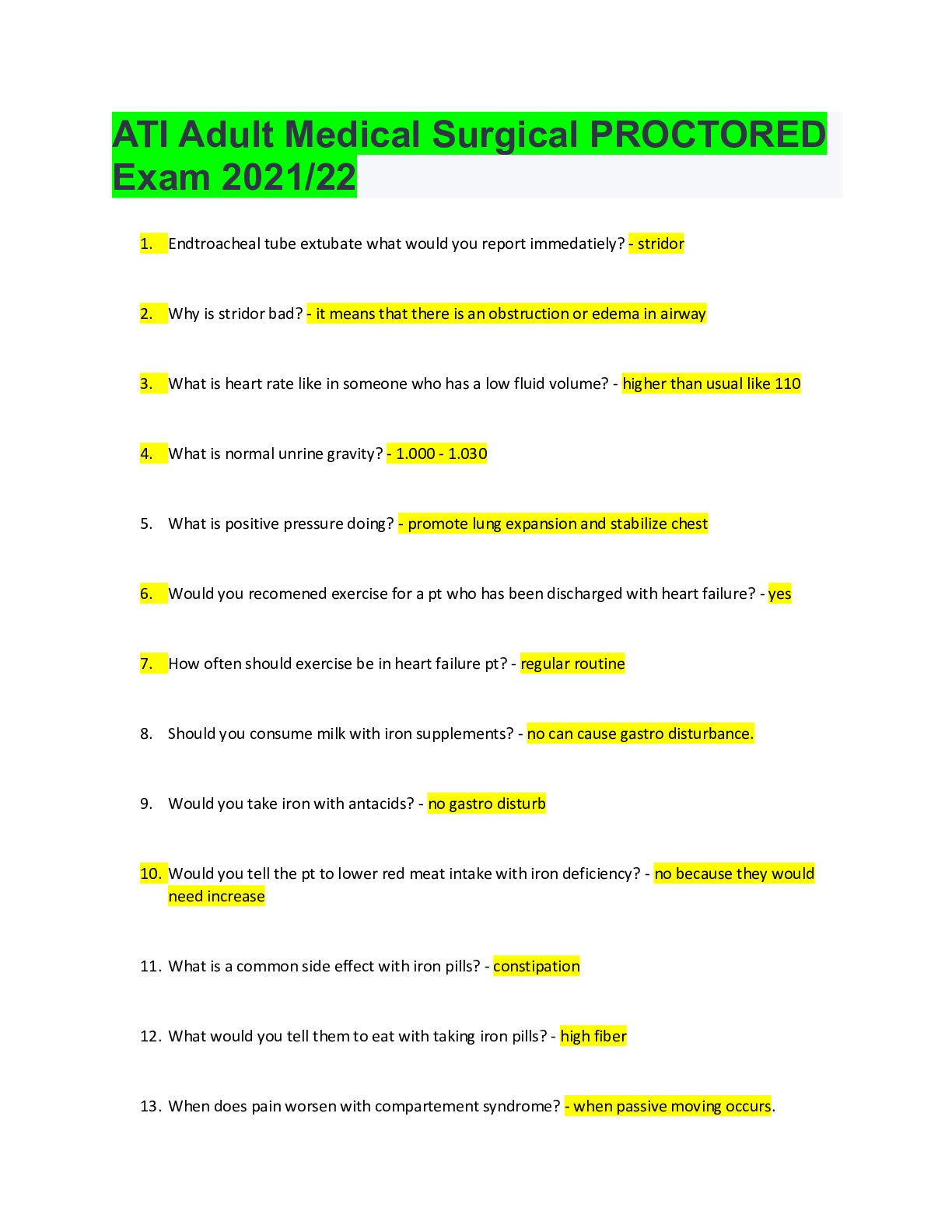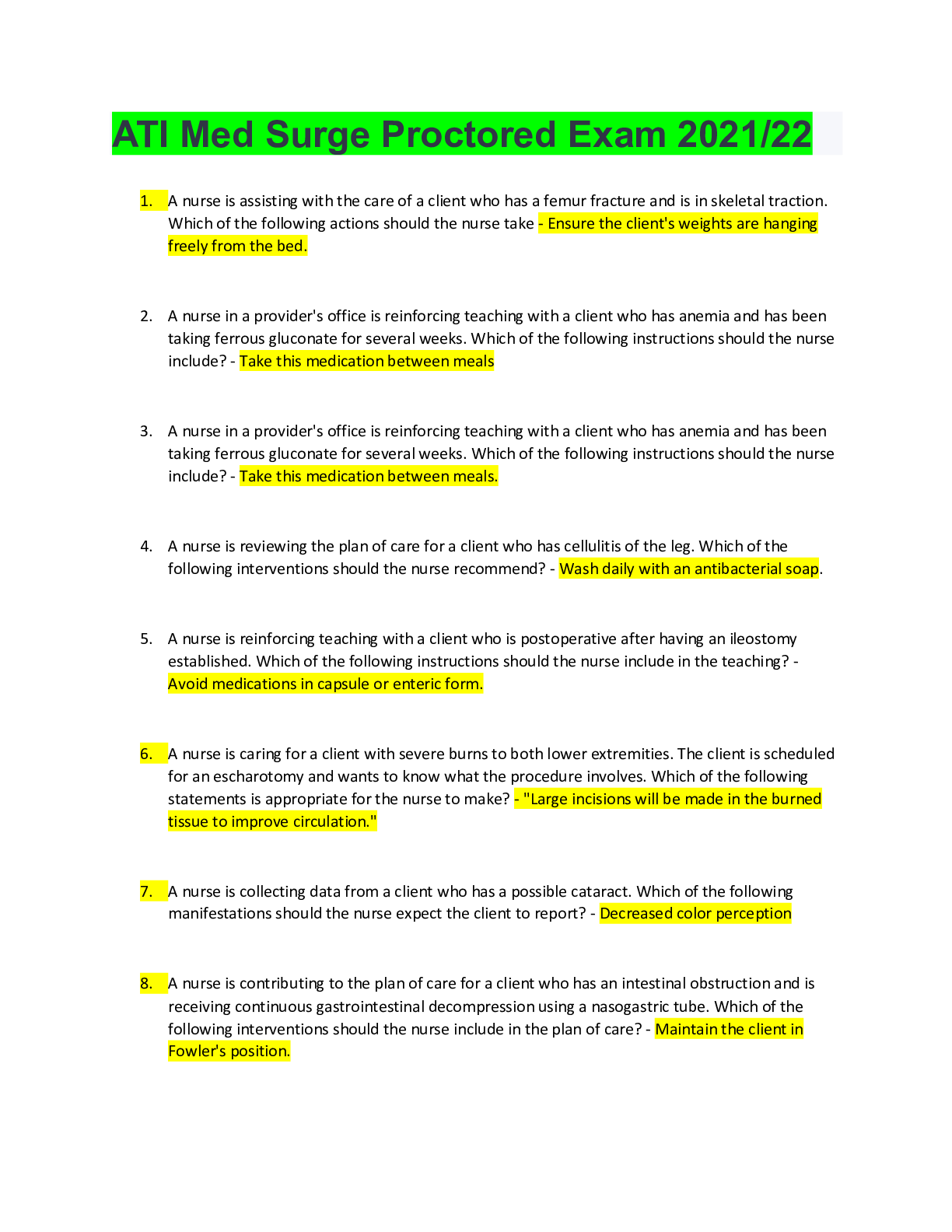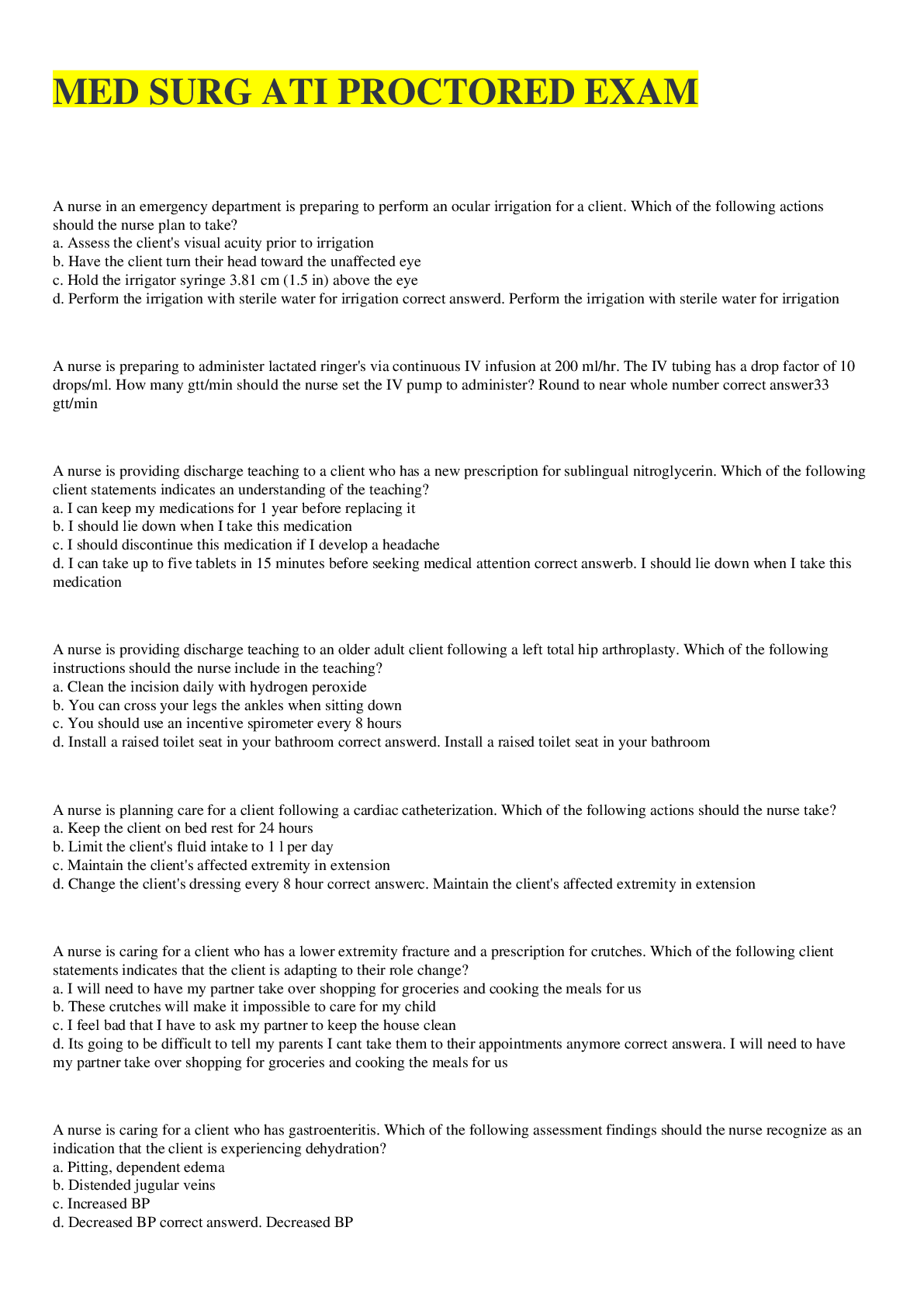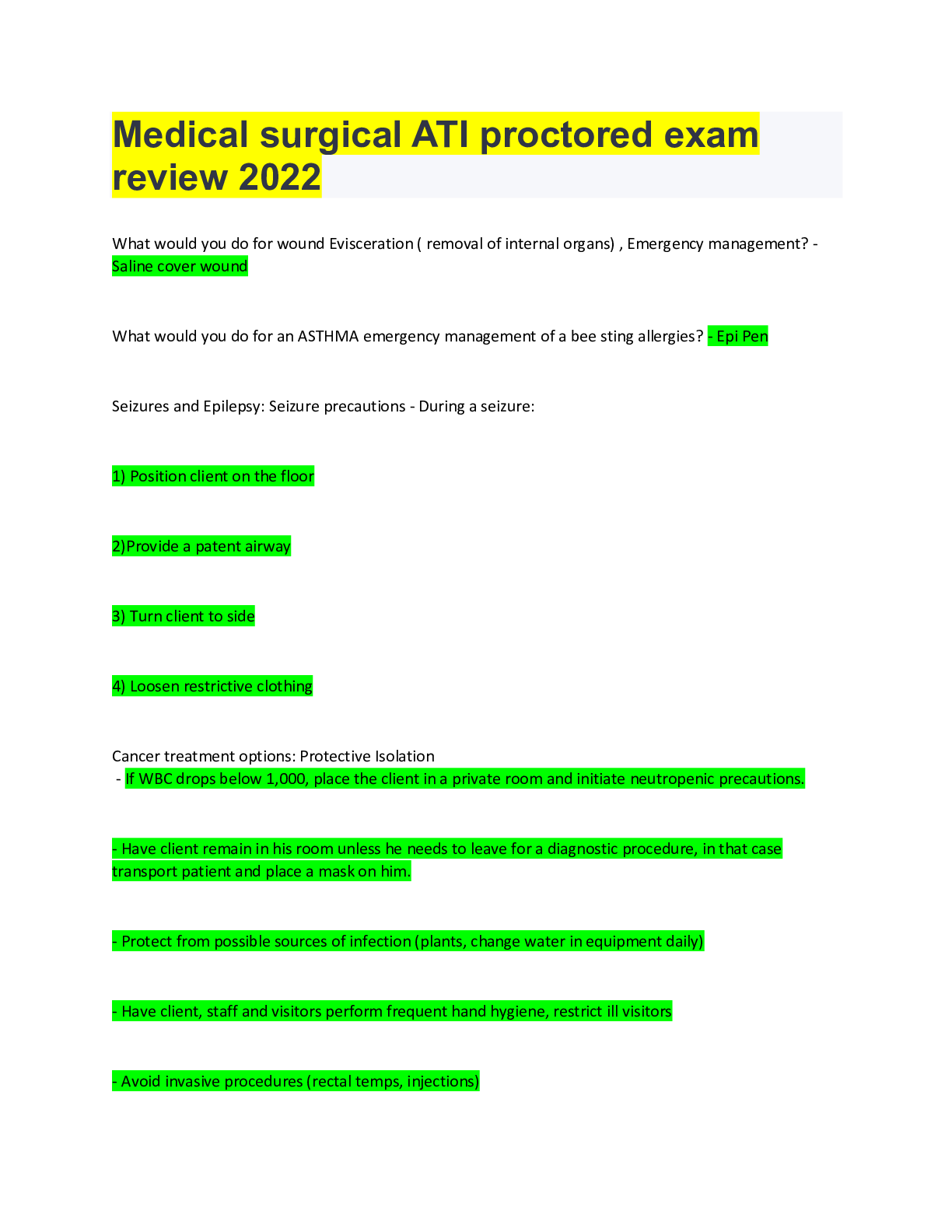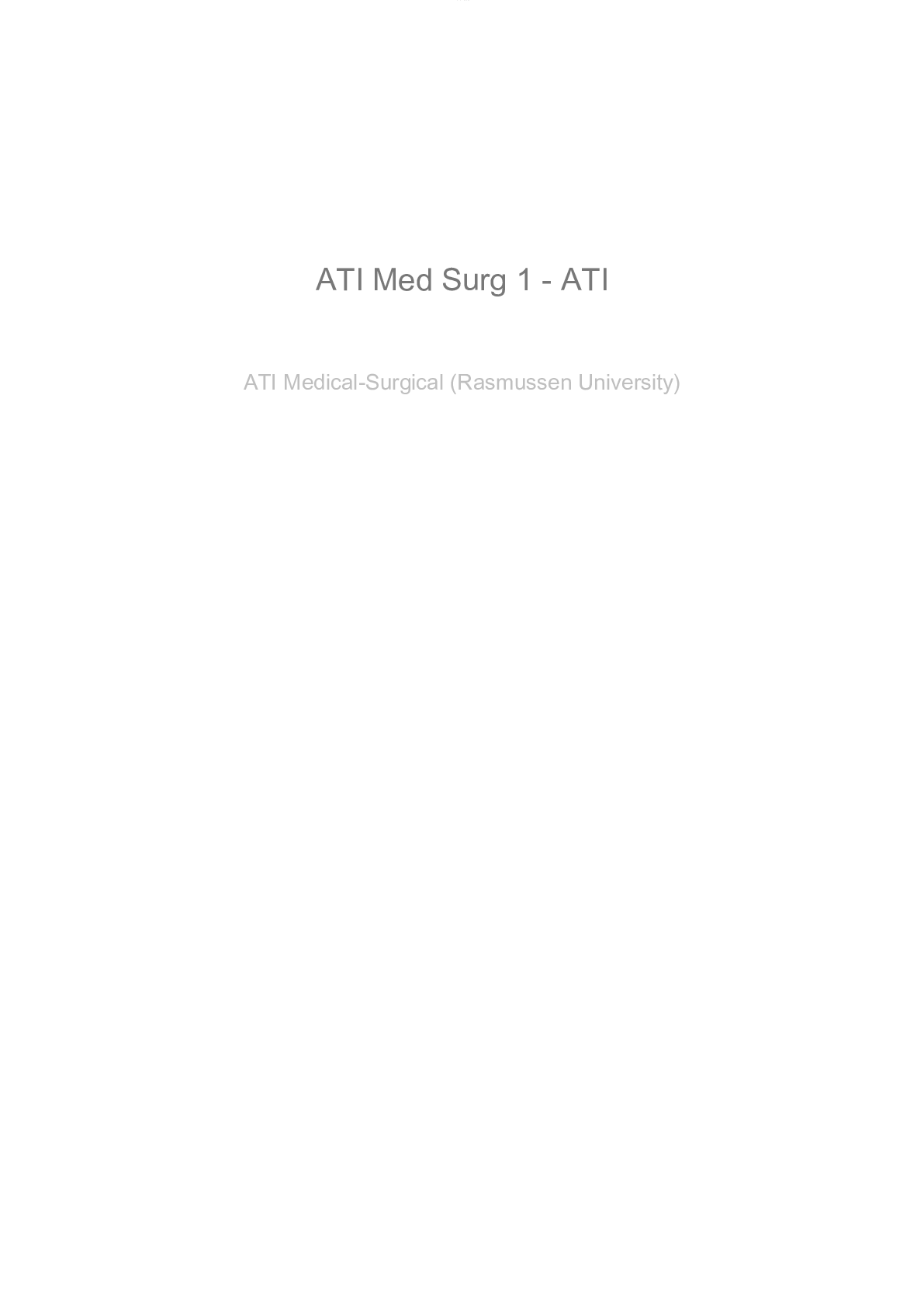*NURSING > MED-SURG EXAM > NURS 225 Care of Patients with Arthritis and Other Connective Tissue Diseases Ignatavicius | Medical (All)
NURS 225 Care of Patients with Arthritis and Other Connective Tissue Diseases Ignatavicius | Medical-Surgical Nursing_8th Edition_Answers with Rationale
Document Content and Description Below
Care of Patients with Arthritis and Other Connective Tissue Diseases Ignatavicius: Medical-Surgical Nursing, 8th Edition MULTIPLE CHOICE 1. A nurse is working with a community group promotin... g healthy aging. What recommendation is best to help prevent osteoarthritis (OA)? a. Avoid contact sports. b. Get plenty of calcium. c. Lose weight if needed. d. Engage in weight-bearing exercise. ANS: C Obesity can lead to OA, and if the client is overweight, losing weight can help prevent OA or reduce symptoms once it occurs. Arthritis can be caused by contact sports, but this is less common than obesity. Calcium and weight-bearing exercise are both important for osteoporosis. DIF: Understanding/Comprehension REF: 294 KEY: Client teaching| health promotion| osteoarthritis| weight loss MSC: Integrated Process: Teaching/Learning NOT: Client Needs Category: Health Promotion and Maintenance 2. A nurse in the family clinic is teaching a client newly diagnosed with osteoarthritis (OA) about drugs used to treat the disease. For which medication does the nurse plan primary teaching? a. Acetaminophen (Tylenol) b. Cyclobenzaprine hydrochloride (Flexeril) c. Hyaluronate (Hyalgan) d. Ibuprofen (Motrin) ANS: A All of the drugs are appropriate to treat OA. However, the first-line drug is acetaminophen. Cyclobenzaprine is a muscle relaxant given to treat muscle spasms. Hyaluronate is a synthetic joint fluid implant. Ibuprofen is a nonsteroidal anti-inflammatory drug. DIF: Remembering/Knowledge REF: 293 KEY: Osteoarthritis| acetaminophen| pharmacologic pain management| patient teaching MSC: Integrated Process: Teaching/Learning NOT: Client Needs Category: Physiological Integrity: Pharmacological and Parenteral Therapies 3. The clinic nurse assesses a client with diabetes during a checkup. The client also has osteoarthritis (OA). The nurse notes the client’s blood glucose readings have been elevated. What question by the nurse is most appropriate? a. “Are you compliant with following the diabetic diet?” b. “Have you been taking glucosamine supplements?” c. “How much exercise do you really get each week?” d. “You’re still taking your diabetic medication, right?” ANS: B All of the topics are appropriate for a client whose blood glucose readings have been higher than usual. However, since this client also has OA, and glucosamine can increase blood glucose levels, the nurse should ask about its use. The other questions all have an element of nontherapeutic communication in them. “Compliant” is a word associated with negative images, and the client may deny being “noncompliant.” Asking how much exercise the client “really” gets is accusatory. Asking if the client takes his or her medications “right?” is patronizing. DIF: Applying/Application REF: 295 KEY: Osteoarthritis| nursing assessment| supplements MSC: Integrated Process: Nursing Process: Assessment NOT: Client Needs Category: Physiological Integrity: Pharmacological and Parenteral Therapies 4. The nurse working in the orthopedic clinic knows that a client with which factor has an absolute contraindication for having a total joint replacement? a. Needs multiple dental fillings b. Over age 85 c. Severe osteoporosis d. Urinary tract infection ANS: C Osteoporosis is a contraindication to joint replacement because the bones have a high risk of shattering as the new prosthesis is implanted. The client who needs fillings should have them done prior to the surgery. Age greater than 85 is not an absolute contraindication. A urinary tract infection can be treated prior to surgery. DIF: Remembering/Knowledge REF: 295 KEY: Osteoarthritis| osteoporosis| joint replacement| surgical procedures MSC: Integrated Process: Nursing Process: Assessment NOT: Client Needs Category: Physiological Integrity: Reduction of Risk Potential 5. An older client has returned to the surgical unit after a total hip replacement. The client is confused and restless. What intervention by the nurse is most important to prevent injury? a. Administer mild sedation. b. Keep all four siderails up. c. Restrain the client’s hands. d. Use an abduction pillow. ANS: D Older clients often have trouble metabolizing anesthetics and pain medication, leading to confusion or restlessness postoperatively. To prevent the hip from dislocating, the nurse should use an abduction pillow since the client cannot follow directions at this time. Sedation may worsen the client’s mental status and should be avoided. Using all four siderails may be considered a restraint. Hand restraints are not necessary in this situation. DIF: Applying/Application REF: 297 KEY: Joint replacement| abduction pillow| musculoskeletal system| older adult MSC: Integrated Process: Nursing Process: Implementation NOT: Client Needs Category: Physiological Integrity: Reduction of Risk Potential 6. What action by the perioperative nursing staff is most important to prevent surgical wound infection in a client having a total joint replacement? a. Administer preoperative antibiotic as ordered. b. Assess the client’s white blood cell count. c. Instruct the client to shower the night before. d. Monitor the client’s temperature postoperatively. ANS: A To prevent surgical wound infection, antibiotics are given preoperatively within an hour of surgery. Simply taking a shower will not help prevent infection unless the client is told to use special antimicrobial soap. The other options are processes to monitor for infection, not prevent it. DIF: Applying/Application REF: 296 KEY: Joint replacement| Surgical Care Improvement Project (SCIP)| wound infection| antibiotics MSC: Integrated Process: Nursing Process: Implementation NOT: Client Needs Category: Safe and Effective Care Environment: Safety and Infection Control 7. The nurse on the postoperative inpatient unit assesses a client after a total hip replacement. The client’s surgical leg is visibly shorter than the other one and the client reports extreme pain. While a co-worker calls the surgeon, what action by the nurse is best? a. Assess neurovascular status in both legs. b. Elevate the affected leg and apply ice. c. Prepare to administer pain medication. d. Try to place the affected leg in abduction. ANS: A This client has manifestations of hip dislocation, a critical complication of this surgery. Hip dislocation can cause neurovascular compromise. The nurse should assess neurovascular status, comparing both legs. The nurse should not try to move the extremity to elevate or abduct it. Pain medication may be administered if possible, but first the nurse should thoroughly assess the client. DIF: Applying/Application REF: 297 KEY: Nursing assessment| joint replacement| musculoskeletal system MSC: Integrated Process: Nursing Process: Assessment NOT: Client Needs Category: Physiological Integrity: Reduction of Risk Potential 8. A client has a continuous passive motion (CPM) device after a total knee replacement. What action does the nurse delegate to the unlicensed assistive personnel (UAP) after the affected leg is placed in the machine while the client is in bed? a. Assess the distal circulation in 30 minutes. b. Change the settings based on range of motion. c. Raise the lower siderail on the affected side. d. Remind the client to do quad-setting exercises. ANS: C Because the client’s leg is strapped into the CPM, if it falls off the bed due to movement, the client’s leg (and new joint) can be injured. The nurse should instruct the UAP to raise the siderail to prevent this from occurring. Assessment is a nursing responsibility. Only the surgeon, physical therapist, or specially trained technician adjusts the CPM settings. Quad-setting exercises are not related to the CPM machine. DIF: Applying/Application REF: 301 KEY: Joint replacement| delegation| continuous passive motion machine| unlicensed assistive personnel (UAP) MSC: Integrated Process: Nursing Process: Implementation NOT: Client Needs Category: Safe and Effective Care Environment: Management of Care 9. After a total knee replacement, a client is on the postoperative nursing unit with a continuous femoral nerve blockade. On assessment, the nurse notes the client’s pulses are 2+/4+ bilaterally; the skin is pale pink, warm, and dry; and the client is unable to dorsiflex or plantarflex the affected foot. What action does the nurse perform next? a. Document the findings and monitor as prescribed. b. Increase the frequency of monitoring the client. c. Notify the surgeon or anesthesia provider immediately. d. Palpate the client’s bladder or perform a bladder scan. ANS: C With the femoral nerve block, the client should still be able to dorsiflex and plantarflex the affected foot. Since this client has an abnormal finding, the nurse should notify either the surgeon or the anesthesia provider immediately. Documentation is the last priority. Increasing the frequency of assessment may be a good idea, but first the nurse must notify the appropriate person. Palpating the bladder is not related. DIF: Applying/Application REF: 302 KEY: Postoperative nursing| joint replacement| nursing assessment| musculoskeletal system MSC: Integrated Process: Nursing Process: Assessment NOT: Client Needs Category: Physiological Integrity: Reduction of Risk Potential 10. A nurse is discharging a client to a short-term rehabilitation center after a joint replacement. Which action by the nurse is most important? a. Administering pain medication before transport b. Answering any last-minute questions by the client c. Ensuring the family has directions to the facility d. Providing a verbal hand-off report to the facility ANS: D As required by The Joint Commission and other accrediting agencies, a hand-off report must be given to the new provider to prevent error. The other options are valid responses but do not take priority. DIF: Applying/Application REF: 304 KEY: Hand-off communication| communication| The Joint Commission MSC: Integrated Process: Communication and Documentation NOT: Client Needs Category: Safe and Effective Care Environment: Management of Care [Show More]
Last updated: 1 year ago
Preview 1 out of 39 pages

Reviews( 0 )
Document information
Connected school, study & course
About the document
Uploaded On
Mar 11, 2021
Number of pages
39
Written in
Additional information
This document has been written for:
Uploaded
Mar 11, 2021
Downloads
0
Views
63

